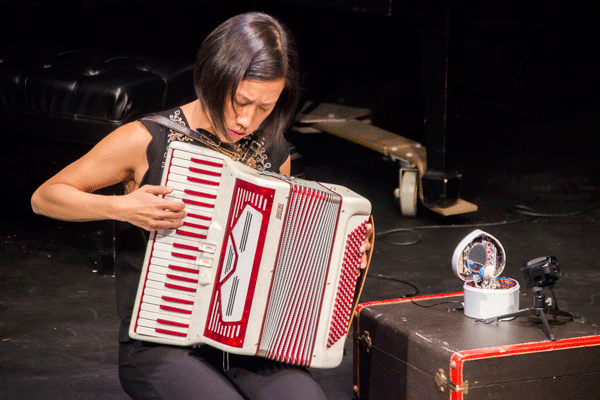
And it was immediately after exiting Parker Theatre that night that a strange sense of mystery and awe fell over my recollection of what went down inside.
For an hour and 15 minutes, music, applause, laughter, whistles, chirps and tearing paper intertwined to bring an audience on an adventure through sound.
It was a concert to celebrate the end of Phyllis Chen’s month as an Artist-in-Residence through the Kenneth Davenport Residency for New American Music at SUNY New Paltz. It was the world premier of her newest work “Columba.” And it was amazing.
Chen had participated in workshops with music students teaching them about new and alternative ways to make music, and worked with them and music faculty members to prepare for this concert.
“The workshops were so much fun and the students were incredibly curious and open and I enjoyed working with all of them,” Chen said prior to the performance. “There was a real momentum of free improvisation and experimental music and I really hope that it keeps up.”
That Tuesday night, Oct. 27, Chen was joined by multiple students and faculty to perform six pieces, including music professor Alex Peh who delivered “Columba.”
“It was so great to have Phyllis here working with the students and to see how courageous she’s been putting sounds into music,” Peh said in his introductory remarks.
The show began with a piece called “Sounds of Childhood.” Written by Pauline Oliveros in 1992, and the first of two Oliveros works played, this piece called for all members of the audience to participate by taking a deep breath and then making sounds they remember from their youth. Slowly but surely almost everyone got involved and all manner of strange calls, clicks, whistles and moans filled the space.
After all had quieted, Chen moved on to the next piece, “Mobius for Two Music Boxes and Electronics.” This piece featured music students Evan Mason and Connor Milton holding music boxes and video artist and electronic musician Rob Dietz on the computer. Chen fed a loop of paper through the two music boxes, and as the students cranked the handles, she poked holes in the strip. She was composing the piece in real time and although there was no real beat or rhythm to grab, it flowed beautifully.
It was time for “Columba.” Peh came out to a small grand piano of which some strings were laced with magnets to create a piercing twang. With the help of a sound box and bird whistle, Peh debuted Chen’s latest work to the world.
Just before Peh picked up the bird whistle and leaned inside the piano, I latched onto a story; my own interpretation of the middle section or climax, if you will: A young boy was walking in a thin forrest. As Peh blew through the whistle, the boy called out to the birds and as chirping started to fill the theatre, they came to fly with him as he walked. But then the tempo quickened and it started to rain in the wood. The boy and the birds began to move fast to get to shelter. He ran and ran, but before he could make it to a big tree, the rain stopped and life moved on.
Chen said “Columba” was inspired by three dimensional collage boxes made by American artist Joseph Cornell. He used many objects to create a surreal world that Chen said she could relate to, as she uses unconventional tools to make art as well.
After much applause, the “Opera with Objects” began. Composed by Alvin Lucier in 1997, this piece was performed with the consistent tapping of two pencils and slowly bringing in other objects by placing a pencil on it and continuing the beat.
The second composition by Oliveros that made its way to this stage was “Thirteen Changes.” A very interesting improv piece during which each of the six musicians plays a few seconds of their interpretation of each of 13 lines of poetry. All performers were playing to the same words but eache individual’s addition was special and unpredictable. The arrangement consisted of two classical guitars, a violin, saxophone, accordion and piano.
One line I found particularly moving read, “Elephants mating in a secret grove.” Everyone on stage seemed to play loud, fast and rough. The pianist reached in and banged on the strings and the sax blared sporadically; none were sweet and gentle. At the time it matched perfectly.
Chen ended the night with another one of her works called “Lighting the Dark,” a four-part piece that involves music boxes, toy pianos and her accordion. The piece was inspired by photos of women in over 55 countries taken by photojournalist Paola Gianturco. Chen said they made her think of all troubles women in the world face.
The four small music boxes had small figurines that twirled to the tunes but they were not traditional ballerinas; they portrayed the struggles felt by many women. And each box kicked off one section of music, although Chen continued to play after the box finished.
This last piece was really emblematic of the whole performance. It took me through a door I didn’t even know I was on the wrong side of.
